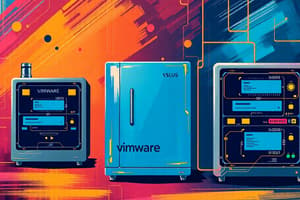Podcast
Questions and Answers
What is the primary function of virtualization?
What is the primary function of virtualization?
- To enhance the graphics capabilities of computers.
- To create a software-based representation of physical components. (correct)
- To improve network speeds through better cables.
- To install additional hardware on a computer system.
What is a sandbox in the context of virtualization?
What is a sandbox in the context of virtualization?
- A type of application for games.
- An isolated testing environment for software development. (correct)
- A cloud storage solution for backups.
- A virtual server that cannot be used for development.
Which of the following best describes a hypervisor?
Which of the following best describes a hypervisor?
- A software layer that enables virtual machines to operate. (correct)
- A type of hardware used for gaming.
- A physical component of a server.
- An interface for network administration.
What is cross-platform virtualization primarily used for?
What is cross-platform virtualization primarily used for?
What is a host machine in virtualization?
What is a host machine in virtualization?
What function does a virtual machine primarily serve?
What function does a virtual machine primarily serve?
What does a virtual hard disk (VHD) do?
What does a virtual hard disk (VHD) do?
Which type of hypervisor runs directly on the physical hardware?
Which type of hypervisor runs directly on the physical hardware?
What effect does over-provisioning virtual machines have?
What effect does over-provisioning virtual machines have?
What is the primary purpose of a virtual router (vRouter)?
What is the primary purpose of a virtual router (vRouter)?
Which statement is true regarding capacity considerations for virtual machines?
Which statement is true regarding capacity considerations for virtual machines?
What is unique about a digital license for Windows installation?
What is unique about a digital license for Windows installation?
What is the minimum number of client systems required for KMS activation to take place?
What is the minimum number of client systems required for KMS activation to take place?
How often do systems activated with KMS attempt to reactivate?
How often do systems activated with KMS attempt to reactivate?
Which of the following operating systems can be activated using ADBA?
Which of the following operating systems can be activated using ADBA?
What happens to a system activated through ADBA when it is removed from the domain?
What happens to a system activated through ADBA when it is removed from the domain?
Which activation method requires no minimum threshold for activation?
Which activation method requires no minimum threshold for activation?
What is the format of a product key for Windows?
What is the format of a product key for Windows?
Which scenario would NOT require system reactivation?
Which scenario would NOT require system reactivation?
What method is NOT used in large environments for Windows activation?
What method is NOT used in large environments for Windows activation?
When does a digital license apply to Windows?
When does a digital license apply to Windows?
What does a major change to the hardware, like a new motherboard, require?
What does a major change to the hardware, like a new motherboard, require?
Which of the following is a way to use a product key for Windows?
Which of the following is a way to use a product key for Windows?
What happens when you sign into a computer using a Microsoft account and connect to the internet?
What happens when you sign into a computer using a Microsoft account and connect to the internet?
Which of the following is NOT a way to obtain a digital license?
Which of the following is NOT a way to obtain a digital license?
Flashcards are hidden until you start studying
Study Notes
Purpose of Virtualization
- Virtualization creates a software-based representation of hardware components or entire systems, allowing multiple operating systems to run on a single physical machine.
- Virtual Machines (VMs) are essential for executing applications and can be hosted on physical servers or personal computers.
Sandbox Virtualization
- Sandbox virtualization creates isolated environments for testing, allowing developers to work without affecting production systems.
- It provides a secure space for software development, installation, and upgrades.
Application Virtualization
- Enables virtual installation and access to applications, reducing licensing costs and increasing accessibility for remote employees.
- Simplifies application maintenance and installation processes.
Legacy Software Access
- Virtualization provides access to outdated proprietary software, even if the user's system runs a newer OS.
Cross-Platform Virtualization
- Allows applications designed for one operating system to be used on another, enhancing compatibility.
Hardware Optimization
- Optimizes physical hardware usage by allowing multiple tasks to be processed simultaneously instead of idling.
Host Machine and Hypervisor
- The host machine is a physical server that shares hardware resources like CPU, RAM, and storage with VMs, managed by a hypervisor.
- Hypervisors (Type 1 and Type 2) facilitate interaction between VMs and hardware without passing through the host OS.
Virtual Machines and Virtual Hard Disks
- VMs are software implementations of computers, operating independently with their allocated resources.
- Virtual Hard Disk (VHD) files simulate hard drives for VMs, acting as storage.
Virtual Networking Components
- vSwitches enable communication between VMs by filtering data packets, while vRouters carry out routing tasks within virtual environments.
- Virtual firewall applications (VFAs) monitor and filter network traffic for security purposes.
Hypervisors
- Hyper-V is Microsoft’s hypervisor, with two types:
- Type 1: Bare-metal hypervisors that run directly on hardware.
- Type 2: Hosted hypervisors that operate on an operating system.
- Popular hypervisors include VMware Workstation and Oracle's VirtualBox.
Digital and Product Keys
- Digital licenses activate Windows without requiring a product key, linked to a Microsoft account and hardware.
- Product keys are necessary for activating versions bought from retailers and must be linked to the specific hardware.
Windows Activation Methods
- Key Management Services (KMS): Requires a local KMS server for client activation, with a minimum of 25 or 5 servers.
- Active Directory-based Activation (ADBA): Automatically activates Windows systems on a domain at startup, requiring no minimum threshold.
- Multiple Activation Key (MAK): Activates systems one-time via Microsoft’s hosting and activates without ongoing communication.
Licensing Management Utility (slmgr)
- Utilized for managing Windows activation:
- /ipk: Installs a product key.
- /ato: Activates Windows.
- /dli: Displays summary license information.
- /dlv: Shows detailed license information.
- /xpr: Displays license expiration date.
Customizing the Start Menu and Taskbar
- Adjust Start menu settings through
Settings > Personalization > Startto show or hide recent, most used apps, or folders. - Taskbar options can be configured through
Settings > Personalization > Taskbar, allowing quick access while minimizing clutter.
Studying That Suits You
Use AI to generate personalized quizzes and flashcards to suit your learning preferences.



